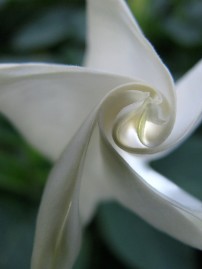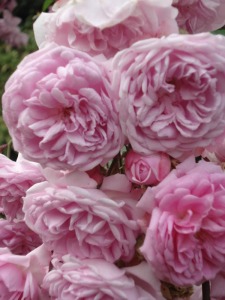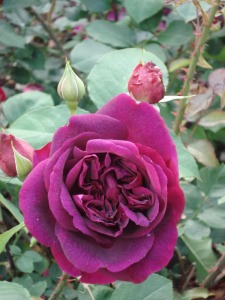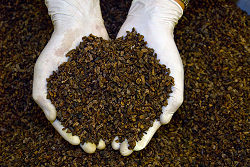The Devil’s Weed. Hell’s Bells. It sounds like something from a gothic novel, a Regency romance, or a horror movie. Perhaps, even the street name for a drug. The latter might actually be quite an appropriate context for the “Devil’s Weed,” a toxic, poisonous, hallucinogenic plant which (Wikipedia says) once drove the soldiers of Jamestown mad, back in 1676.
The Devil’s Weed (aka, Hell’s Bells, Devil’s Trumpet, Angel’s Trumpet, Brugmansia, and many other names) is scientifically known as the Datura Stramonium plant and is a type of deadly nightshade with truly revolting looking pod seeds that resemble something out of a Tim Burton movie. Yet, its delicate, summer-blooming flowers are often used in perfumery because they are said to smell of sweet apricots or plums. In perfume, the Devil’s Weed goes by the much more innocuous sounding name of the Datura flower.
That flower is the ostensible inspiration behind Datura Noir, a perfume created by Christopher Sheldrake for Serge Lutens. It was released in 2001 and it seems that it may soon be discontinued. Though there has been no official announcement (there rarely is), I’ve read numerous comments claiming that the perfume will be discontinued in as soon as a few months. It is currently on the Serge Lutens website which describes the perfume as follows:
Like a diabolic trail of smoke left by Satan in Paradise.
Some say this fragrance will enthrall you; others that it will make you crazy. Others still that excessive exposure will kill you dead.
To be precise, one night I took brugmansia, also known as Angel’s Trumpet, and distilled the notes of its lingering memory.
What a description! My word! If only the perfume lived up to it….
 Let me be as blunt as possible: Datura Noir is about as satanic, dark, “Noir” and diabolical as raindrops on roses and whiskers on kittens. It is a perplexing perfume that has left me completely unable to make up my mind about anything but the fact that it is most definitely NOT diabolically dark. You see, Datura Noir is all creamy white coconut, creamy white tuberose, and bitter white almonds. I like two of the three things very much. Unfortunately, creamy coconut… not so much. And, on my skin, this is a very coconut-y perfume.
Let me be as blunt as possible: Datura Noir is about as satanic, dark, “Noir” and diabolical as raindrops on roses and whiskers on kittens. It is a perplexing perfume that has left me completely unable to make up my mind about anything but the fact that it is most definitely NOT diabolically dark. You see, Datura Noir is all creamy white coconut, creamy white tuberose, and bitter white almonds. I like two of the three things very much. Unfortunately, creamy coconut… not so much. And, on my skin, this is a very coconut-y perfume.
Fragrantica classified Datura Noir as an Oriental Vanilla (I’d call it a Floral Vanilla, myself), and provides the following notes:
coconut, tuberose, tonka bean, almond, lemon blossom, mandarin orange, musk, chinese osmanthus, heliotrope, myrrh, vanilla and apricot.
The first time I tried Datura Noir, it opened on my skin with an explosion of buttery vanilla and almond, followed a few minutes later by fruity floral notes that were hard to isolate. For a second, I also thought I smelled green plums and, possibly, apricots — but it soon disappeared. Underlying them all was coconut which resembled just slightly Hawaiian tropical oils. I’m not usually crazy about the note and, yet, it worked in some odd way — perhaps because it was extremely mild and fleeting, and because it was alleviated by the almond note.
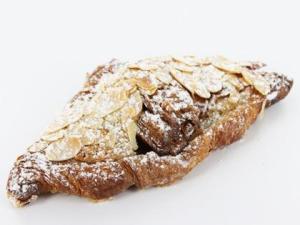 The almond was absolutely heavenly. At times, it was bitter; at others, sweet and warmed by the vanilla. I detected the heliotrope which not only resembles almonds but which also has a slightly sweet powdery element with a touch of light violets. While heliotrope can sometimes lead to a “Play-Doh” impression, it doesn’t here. This is all almonds and vanilla, and it strongly brings to mind the almond paste with vanilla (pate d’amande) that French patisseries love to use in some croissants. I’m rather in love with it, especially as it isn’t cloying or insanely sweet. The reason is that the sweetness has a definite bitter edge, like the kernels of fruit were freshly crushed. In addition, the vanilla isn’t like highly sugared cupcake frosting. At times, it was rather like French patisserie dusting powder; strong but simultaneously light. At other times, it was rich vanilla, as if from pure Madagascar beans, and had a definitely custardy, creamy aspect to it.
The almond was absolutely heavenly. At times, it was bitter; at others, sweet and warmed by the vanilla. I detected the heliotrope which not only resembles almonds but which also has a slightly sweet powdery element with a touch of light violets. While heliotrope can sometimes lead to a “Play-Doh” impression, it doesn’t here. This is all almonds and vanilla, and it strongly brings to mind the almond paste with vanilla (pate d’amande) that French patisseries love to use in some croissants. I’m rather in love with it, especially as it isn’t cloying or insanely sweet. The reason is that the sweetness has a definite bitter edge, like the kernels of fruit were freshly crushed. In addition, the vanilla isn’t like highly sugared cupcake frosting. At times, it was rather like French patisserie dusting powder; strong but simultaneously light. At other times, it was rich vanilla, as if from pure Madagascar beans, and had a definitely custardy, creamy aspect to it.
That lovely, slightly gourmand opening happened the first time I tried Datura Noir. The second time, however, it was almost entirely thick coconut and tuberose. It was an astonishing — and extremely stark — difference. I actually couldn’t quite believe it. Yes, there was some bitter almond vanilla, but it skulked in the background as if it were a red-headed stepchild about to be beaten by its abusive parents. This opening was overwhelmingly hotly buttered, heavy, gooey coconut with indolic tuberose trailing just a step behind. The almond-vanilla notes came later — as if the order had been reversed — but even then, it was still mild and submissive.
The sharp contrast certainly substantiates the review at Now Smell This which noted how the perfume can change on your skin from day-to-day:
At times it seems to perfectly conjure up the mystical connotations of the Datura flower, and so I tend to think of it as a sexy, secret rendezvous kind of perfume, not something to be worn by the light of day. Other times, the almond in particular seems to strike a jarring note, as though you had shown up for an assignation with a tall, dark stranger and found only a dainty plate of Amaretti cookies. Then there is nothing to do but scrub it off and try again another day.
I’m not sure that Datura Noir ever became “a sexy, secret rendezvous kind of perfume” on my skin. Irrespective of the opening, the perfume consistently developed in its middle and final stages into a buttery coconut and creamy tuberose scent. There were always traces of almond and vanilla, but they never trumped the other two, more dominant notes. There were also varying degrees of soft apricot from both the osmanthus and the datura, but the aroma was more like the almond-y kernel than that of the sweet fruit. Lastly, there was an extremely light musk note that consistently developed on both occasions during the final hour but it was extremely subtle; powdered vanilla was a much greater undertone. None of this screams sexy, clandestine rendezvous to me. And I’m afraid the perfume never morphed beyond what I described. Unlike a few reviewers, I never once smelled myrrh (which I think might have helped) or mandarin orange peel.
In short, I never found anything remotely evoking seductive danger. Had I not read up on the history and nature of the Devil’s Weed, I would have been utterly baffled by the references in reviews such as the enormously positive one at Perfume-Smellin’ Things. There, she found Datura Noir to be the scent of a sweet woman driven to dark things:
In my imagination, the delicate, passive Farnesiana [by Caron] has an alter ego…because there is only so much a sweet-natured girl can take… push her to the limit and we’ll be looking at your necrologue in The NY Times. If you make her really, really angry, Farnesiana turns into Datura Noir, which is anything but delicate or passive. What unites the two for me is the bitter almond quality presented on a creamy floral background. And it is that quality that also makes them oh so different.
In Farnesiana, the almond-heliotrope accord is a soft, if melancholy embrace. In Datura Noir, it is a soupçon of cyanide in your champagne. […] The tuberose, the presence of which lends the composition a languid, tropical feel, is wonderfully creamy, and makes a perfect seductive accomplice to the evil almond. “Very few of us are what we seem,” warns Agatha Christie. That certainly describes Datura Noir. Delicious but poisonous, beautiful but lethal, creamy-white but with the heart of darkness, it will kill you, but softly…if that’s any consolation.
My position is much closer to that The Perfume Shrine which found Datura Noir to be “schizophrenic,” changing perceptibly each time, and not necessarily for the better:
It has the almond nuance of cyanide we read about in novels, yet dressed in edible apricot and tropical fruit and floral notes (candied tuberose clearly present) as if trying to belie its purpose, while at the same time it gives the impression of coconut-laced suntan lotion smelled from afar; as if set at a posh resort in a 1950s film noir where women are promiscuous and men armed to the teeth beneath their grey suits and there’s a swamp nearby for dumbing [sic] bodies in the night…
Initially, I didn’t agree one whit with the scene described but, on my second test of Datura Noir, I could definitely understand why it came to mind. The second version of Datura Noir actually does have a very 1950s Miami gangster/moll vibe to that tropical tuberose accord; one can definitely imagine an overly sexual, over-blown blonde bombshell in a bathing suit, hanging by the side of a Mafia henchman. And, in fact, the Starz premium-cable network has a series called Magic City set in the 1950s that is about the exact scenario invoked by the Perfume Shrine. (Really. A Miami hotel, the Mafia, beautiful women, and dead bodies dumped repeatedly in an ocean grave.)
A similar — but significantly harsher — impression came from “Feysparrow” on Makeupalley who wrote:
Usually a perfume that says ‘bad girl’ this shamelessly is found in drugstores…[b]ut Datura Noir, expensive it might be, was designed to smell this cheap. It’s quite clever in a way, right up there with selling ‘antiqued’ furniture and ripped jeans.
It’s tropical and cloying. It’s brazen. It tells passersby, ‘I have done things with many people and I will do those things with you, if you like’. I’m not extrovert enough to even begin to imagine I could carry this off, the thought alone makes me feel headachy and dissolute. I like the scent of datura flowers in real life but here their scent is duplicated with an accord of white flowers, one of which is tuberose which smothers the others to death before I can tell what they were. The tuberose is in turn slaughtered by the coconut, my least favorite note of all time – but of course it has to have coconut, it just wouldn’t be cheap-smelling enough without a heavy hit of coconut. Finally, a flood of almond, apricot, and sweet vanilla adds a gourmand quality to the indigestible heap and in a last gesture of vulgarity, the bad girl says, “Eat me.”
Ouch! I don’t think Datura Noir smells cheap (in the sense of low-cost, poor quality ingredients), but I can understand the comparison to a cheap, brazen woman. It’s all due to that bloody coconut which is simply too over the top here. Too unctuous, too heavy, too dominant, too much of a bad partner for something as rich as tuberose.
As you can tell, I much preferred my first version of Datura Noir, though the coconut element was still a bit too much for me even then. But, as should be equally clear from some of these comments, one doesn’t seem to have a guarantee as to which version of the perfume will show up. To be fair, there are a few really positive reviews for it on Makeupalley and even more on Fragrantica (where it is occasionally compared to Dior’s Hypnotic Poison). However, as a whole, this is a scent which seems to trigger a strong “love/hate” reaction — sometimes within the same person. I felt a bit like the MakeupAlley poster, “myolderbrother,” who wrote: “Unfortunately, the awesomeness isn’t consistent. I’m quite confused with this scent and seem to have a love/dislike affair with it.”
Equally inconsistent are the reports on the perfume’s sillage and longevity. On me, the perfume had good-to-great projection for the first hour on my first try when I put on a fair bit; it had good-to-low projection on my second test when I put on less. In both cases, however, the perfume became much less powerful in the second hour and almost close to the skin. It became fully close to the skin in the third hour. On Fragrantica, the majority of people found the sillage to be merely “moderate.” In terms of longevity, on my first test, there were lingering traces of the scent in the seventh hour; on the second attempt, it didn’t last past five hours. Elsewhere, the reports range from “it barely lasted” to comments about great longevity.
One thing should be noted about Datura Noir. Its name seems to come up often in discussions of Guerlain‘s Mayotte or, as it is more frequently called, Mahora (the perfume’s original name). I’ve reviewed the notorious Mahora and I have to say, the two perfumes are nothing alike. For one thing, there is no edible, gourmand component to Mahora. For another, Mahora had some seriously green aspects to it at first, before turning into a predominantly tuberose perfume with some coconut in it. Datura Noir, in contrast, is a primarily coconut-tuberose (and almond) perfume and the difference in degree is quite large. While both are very, very buttery, Datura Noir seemed much lighter and airer (relatively speaking) the first time around, but significantly heavier the second. I think I prefer Mahora — not only because of the way that the tuberose manifested itself, but also because it wasn’t such a bi-polar, bewildering perfume.
If all of this leaves you confused, well, join the club. I simply don’t know what to think of Datura Noir. Normally, I have an opinion one way or another — but Datura Noir is a bit too much of a drastic chameleon for me to know its true nature. The Perfume Shrine called it a schizophrenic kaleidoscope, and said so with a shiver. But those who love it, seem to do so passionately. If the rumours about it being discontinued soon are true (and I’m hearing them repeatedly), then you may want to give it a sniff soon to decide for yourself. It will either be your “Angel’s Trumpet,” or you’ll find yourself swearing, “Hells Bells, this is the Devil’s Weed!”


